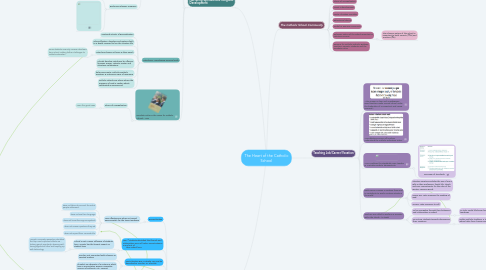
1. Spirituality and the Kids of Today
1.1. Evangelisation
1.1.1. Loss effectiveness when not aimed appropriately for the target audience
1.1.1.1. does not take into account the actual people addressed.
1.1.1.2. does not use their language
1.1.1.3. does not know their signs & symbols
1.1.1.4. does not answer questions they ask
1.1.1.5. does not impact their 'concrete life'
1.2. Year 7 students identified that friends and relationships were of higher importantance in and out of their school lives
1.2.1. School is not a major influence of students lives. Society has the largest impact on student lives
1.2.1.1. Monash University researcher identified that top most important effects are : looking good, popularity, dressing well, having significant other and keeping up with technology
1.3. Post-Christian Era: Australia can now be described as 'secular' or 'pluralist'
1.3.1. Secular: Not connected with religious or spiritual matters
1.3.2. Pluralist: an advocate of a system in which two or more states, groups, principles, sources of authority, etc., coexist.
1.4. Catholic schools now face many challenges in this 'Post-Christian Era'
1.4.1. .
1.5. Teaching generation 'Z'
1.5.1. 'Tribalism' replaces peer pressure from previous generations
1.5.1.1. Tribalism: a loyal collection of friends, often treated as 2nd family
1.5.1.2. Tribalism is more important than personal identity due to to: high divorce rates among parents, drug culture and technology/social media
1.5.2. Constant social interaction in and out of school via technology, leaving the most positive aspect of school the social aspect.
1.6. All beings have spirit
1.6.1. The principle of conscious life
1.6.2. Spirituality - Who I Am
1.6.3. Spirituality = the landscape
1.6.3.1. Faith = the map
1.6.4. Religious Education links to the nurturing and development to spirituality
2. Nurturing Spiritual and Religious Development
2.1. Religious Education - Learning Area
2.1.1. Share catholic faith by promoting knowledge & understanding of the gospel
2.1.2. Never to be seen as 'less important' than other learning areas
2.1.3. will have students reflect on learning as in other learning areas
2.1.4. Many resources available with step by steo instruction and unit plans for all ages
2.1.4.1. Let the Little Children Come to Me
2.1.4.1.1. Complements the EYLF
2.1.4.1.2. Play based learning
2.1.5. Religious Education should always be age and developmentally appropriate
2.2. Proclamation - Religious Awareness
2.2.1. Awareness lacking in affluent and materialistic societies
2.2.2. Parents can hinder students awareness if focus is on material world and affluent lifestyle
2.2.3. can be 'awoken' through appriecation of created univerese
2.2.3.1. Excursions, studies of nature, studies of science,
2.2.4. reflection & discussion of questions of the human heart
2.2.5. Growing awareness of their personal experiences and their need of God
2.2.6. Reminders of the presence of God
2.2.6.1. Chapels, Crucifix etc:
2.2.7. Exploring religious programs
2.2.7.1. .
2.2.7.2. .
2.3. Catechesis - Developing Personal Faith
2.3.1. Centered activity of Evangelisation
2.3.2. When effective, develops and matures faith to a depth required to live the christian life
2.3.3. catechesis begins at home & their parish
2.3.3.1. Some students now only reiceve catechesis from school, adding further challenges to Catholic Education
2.3.4. schools develop catechesis by offering: liturgies, prayer, retreats, Easter and Christmas celebrations.
2.3.5. helps appreciate: Catholic symbols, practices & customary signs of reverence
2.3.6. Catholic schools are places where the presence of God is spoken about, celebrated & experienced
2.4. Mandate Letter is the vision for Catholic Schools - GPS
2.4.1. Places of evangelisation
2.4.1.1. Learn the good news
3. The Catholic School Community
3.1. Places of evangelisation
3.2. Assist in development
3.3. Foster Christian mentality
3.4. Educational choice
3.5. Models a genuine community
3.6. Religious nature of the school important in selection process
3.6.1. The religious nature of the school in important to both Parents (12th) and Teachers (8th)
3.7. Reasons for Catholic Schools: Bishops, Teachers, Parents, Students and the Mandate Letter
4. Teaching Job/Career/Vocation
4.1. "The answer is clear and unambigious: good teachers make a good school under the leadership of a competent and caring principal"
4.2. Accreditation ensures all teachers understand the Catholic education sector
4.3. AITSL Outlines the standards every teacher in Australia needs to demonstrate
4.3.1. Overview of standards
4.4. Each person is given a vocation from God to contribute to God's creative activity in the world
4.4.1. Christian vocation includes the use of one's gifts in their profession, family life, church and civic commitments for the sake of the greater common good.
4.4.2. Missio Dei: Latin meaning the sending of God.
4.4.3. Vocare: Latin meaning 'to call'
4.5. Teachers are called to preform a 'ministry' withe the church - to teach
4.5.1. To be evangelise through their behaviour and relationships in school
4.5.1.1. To truly model life being lived by Christ's teachings
4.5.2. To nurture students towards discovering their vocations
4.5.2.1. Within Catholic tradition, a teacher is one whom helps form 'human persons'

